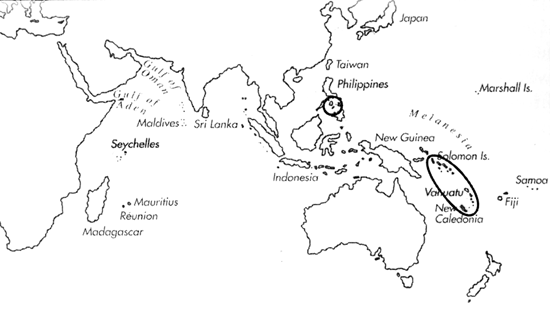
Skip Navigation Links
View access keys for this site.

Range: New Caledonia, Solomon Is., Vanuatu, and Philippines; probably also Amirante Is.
Description: Medium-sized to moderately large, moderately light to moderately solid. Last whorl usually ventricosely conical or conical; outline convex adapically, straight below; left side somewhat concave near base. Shoulder angulate to subangulate. Spire usually of moderate height, outline variably concave. Larval shell of about 2.25-2.50 whorls, maximum diameter 0.8-0.9 mm. First 3-7 postnuclear whorls tuberculate. Teleoconch sutural ramps flat to slightly concave, with 0-1 increasing to 3-4 spiral grooves; latest ramps with faint or obsolete grooves but many additional spiral striae. Last whorl with widely spaced spiral grooves on basal third or half.
| Shell Morphometry | ||
|---|---|---|
| L | 35-63 mm | |
| RW | 0.07-0.17 g/mm | |
| (L 32-52 mm) | ||
| RD | 0.49-0.54 | |
| PMD | 0.78-0.87 | |
| RSH | 0.12-0.25 | |
Ground colour white. In light-coloured specimens, last whorl with a generally fine and often incomplete, brown or orange reticulate pattern and variously sized flecks aligned in a spiral row on each side of centre; sometimes pattern only of scattered curved or zigzag-shaped axial dashes. In dark-coloured specimens, last whorl covered with large dark violet-brown zones and bluish background shadows leaving only sparse blotches and tents of white. Larval whorls light brown. About first 2 postnuclear sutural ramps brown. Following spirewhorls matching last whorl in colour pattern. Light-coloured shells with a white aperture, pale pink or violet; dark-coloured shells with a bluish white aperture.
Periostracum thin, very translucent and smooth.
In specimens with a light-coloured shell, dorsum of foot white, mottled with tan on anterior part, heavier medially. Siphon white, mottled with tan on dorsal side of proximal portion (Estival, unpubl. observ.).
Habitat and Habits: In 3-60 m on sand; active at nightfall and reported to prey on worms (Tirard, pers. comm., 1989).
Discussion: C. lienardi resembles C. neptunus, C. cinereus, C. oishii, and C. iodostoma. C. neptunus attains larger size, has white larval whorls, and its last whorl is generally less ventricose but straighter in outline. For comparison with C. cinereus, C. oishii and C. iodostoma, see the DISCUSSIONS of these species.

C. lienardi range map
This section contains verbatim reproductions of the accounts of 316 species of Conus from the Indo-Pacific region, from Manual of the Living Conidae, by Röckel, Korn and Kohn (1995). They are reproduced with the kind permission of the present publisher, Conchbooks.
All plates and figures referred to in the text are also in Röckel, Korn & Kohn, 1995. Manual of the Living Conidae Vol. 1: Indo-Pacific Region.
The range maps have been modified so that each species account has it own map, rather than one map that showed the ranges of several species in the original work. This was necessary because each species account is on a separate page on the website and not confined to the order of accounts in the book.
Return to framed version (returns to search page)